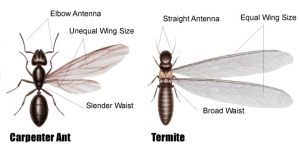Just when you thought you knew everything about the bad things that happen when you don’t repair your gutters…along comes the ant parade.
Carpenter ants come in a variety of shapes sizes and features and are attracted to wet, damaged areas of houses.
Red Flag #1: Big Ants – Sometimes with Wings
A quarter-inch to half an inch long these Carpenter ants can vary in colour, from black to brown even red, ranging in 5 different sizes and variations depending on their role in the colony. Unlike termites, carpenter ants don’t actually eat the wood; they just tunnel through it, chewing as they go to create a labyrinth of tunnels. You will often find them in the kitchen or bathroom area as they look for food supplies, maybe even crawling out of drain pipes. They are most commonly spotted during spring and early summer but reproductive (the ones with wings) carpenter ants can be roused as early as January if their nest is inside, otherwise the ones living outside in decaying wood along the house, logs and stumps will not be active until about early May. Once fertilized the queens must then find more wet wood for a new nest, and the circle of life continues much to the despair of home owners.
Note: Termites also have wings but their antennae are straight, their middle nodule is much wider than a carpenter ant and they also have a second set of smaller wings.
Red Flag #2: Frass or Sawdust
As the carpenter ants tunnel through wood, they leave behind a type of sawdust called frass. Crawl spaces, dark areas, cupboards and corners are the areas where you will most likely find this debris.
Red Flag #3: Rustling Sounds
Hearing weird rumblings and nibbling from behind your walls? This rustling paper sound is the sound of a happy colony of carpenter ants chewing their way to freedom.
Red Flag #4: Damaged Wood
Once you’ve seen the frass and heard the rustling sounds, you will inevitably find damaged wood. You are looking for small rectangular holes, which are the entryways to tunnels that run deeper into the kingdom.
So I’ve got carpenter ants, what should I do?
Keep wooden parts of the house and other structures dry by making necessary repairs to roofs, flashing, gutters and downspouts. Replace any water-damaged, decaying wood. Any steps you take to get rid of the ants will be unsuccessful as long as there is wet wood to attract them.
To abolish carpenter ants, all the parent and satellite colonies must be destroyed or the ants will be right back in a few days or weeks. Once the wet wood is repaired and steps have been taken to ensure there are no more leaks, boric acid may be poured into into nests and cavities to kill the ants. If you don’t know where the nests are or can’t access them the boric acid can be used in combination with a bait. Most likely you will need the help of a professional pest management company.











Leave A Comment